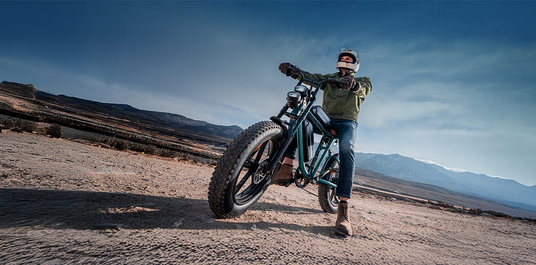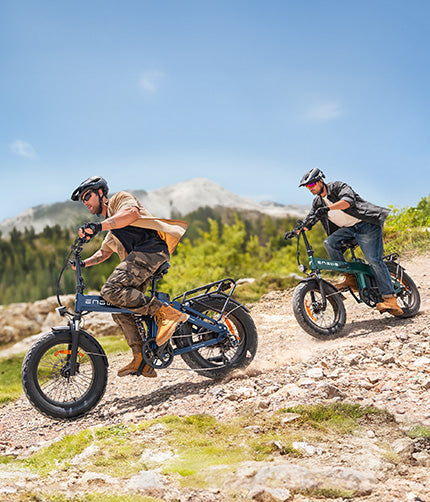The daily commute. For many people, it’s a stress machine, a twice-a-day heaping helping of aggravation — traffic jams, crowded buses and trains, unpredictably long commutes. What’s more, what if it could be the best part of your day? An electric bike is a symbol of this transformation, transforming a chore into a moment of liberation and mild exertion. But the market is crowded, and seeking out the “best commuter e-bike” can feel almost as stressful as the commute itself. This guide aims to help you cut through the noise. We’re not just going to recite the features; we’re going to get to what really matters on the rain-slicked streets of a British city, what it is about a bike that you want to ride day after day, and what to look for in the one that will truly enhance your life.
What Really Makes an Electric Bike the Best for Commuting?
But before we get to the nitty-gritty specs, let's define our terms. A great commuter e-bike isn’t a mountain bike with some stuff bolted onto it, nor is it a road bike with a battery accoutrement. It's a no-compromise vehicle that is specifically engineered for the needs of urban and suburban transportation. Its good points are reliability, comfort, and sensibleness. Consider it an efficient four-wheeled friend with one extra wheel and a much smaller footprint. The central philosophy here is to get you from A to B efficiently, safely and in a calm state of readiness for the day ahead, rather than a dishevelled, stressed-out sweaty mess. Which is all a roundabout way of saying you should look for an upright, comfortable riding position that lets you see over traffic; mudguards to keep the puddle splashes away; a pannier rack to carry your laptop bag; and built-in lights that mean you’re never caught out by dusk.
Reading Between the Jargon: What a Good Commuter E-Bike Should Have
Knowing some specific things will be beneficial while making a decision.
The Motor
The motor is the heart of the electric bike, but not all motors are the same. A torque sensor is far better than a cadence sensor for a natural riding experience. A cadence sensor only senses whether you’re pedalling and delivers a standard amount of power; this may be rough or disjointed. A torque sensor, however, gauges how hard you are pressing on the pedals and delivers a similarly proportional amount of assistance. It’s like you’ve got bionic legs; the bike scales your own exertion perfectly.
The Battery and Range
Be realistic with the manufacturer’s claims, which may be under ideal conditions. Figure out your daily round trip, add a 30 per cent buffer for headwinds, hills or days when you just want to crank it up to a higher power setting, and make sure that the bike’s battery will get you there. A removable battery is a huge bonus – you don’t have to bring the bike inside to charge, just the battery, which can be put on charge under a desk or in your flat.
Brakes
You must be able to stop quickly and safely when you are working in city traffic. Hydraulic disc brakes are vastly superior to their mechanical analogues or older rim brakes, stopping more quickly and with better modulation, especially in the wet.

A Commuter's Dream Fulfilled: The ENGWE P275 SE in Action
Our Recommendation: A Commuter's Dream Fulfilled
Most bikes out there have some of these features, but the aim is to find one that makes them all mesh together perfectly. Based on my experience, one bike that I’ve found impressive as the perfect commuter’s bike is the ENGWE P275 SE. At the heart of this bike is a 250W motor, but the real hero is the smart torque sensor. It offers one of the smoothest, most natural power-assist functions around, a whole world away from the jerky action of some inferior systems. There’s nothing stopping you from travelling! With an impressive range of up to 100km per single charge (powered up by a high-capacity 36V 13Ah battery). Most importantly, this battery is completely detachable so you can charge it easily at your desk or in your house. Safety comes first, for which we’ve included high-quality front and rear hydraulic disc brakes, which deliver reliable, powerful all-weather stopping power. It has dual suspension to handle all the bumps while you ride over your most challenging trail. It’s also as comfortable as it gets, with cush built right in: a 6061 aluminium alloy frame means an upright posture, and 27.5-inch city tyres take potholes in their stride. It’s the little extras that make the ENGWE P275 SE one great all-round commuting model: a chain guard to bid farewell to trouser clips, front and rear lights built-in for visibility, an intelligent LCD display to make sure you’re in the know with all your ride data, and the possibility of connecting to a smart App for refined control and navigation.
| Feature | Specification |
|---|---|
| Motor | 250W with torque sensor |
| Battery | 36V 13Ah, detachable |
| Range | Up to 100 km |
| Brakes | Front and rear hydraulic disc brakes |
| Suspension | Dual suspension |
| Frame | 6061 aluminium alloy |
| Tyres | 27.5-inch city tyres |
| Extras | Built-in lights, chain guard, LCD display, App connectivity |

Testing It Out: This Is What Your Daily Commute Looks Like Converted
Let's imagine a typical journey. You go out on a grey morning. Your house is locked, and you are ready to roll as soon as you throw a leg over the bike; you’ll notice that the upright riding position and bars simply fall under your hands, and you’re in full control. As you accelerate, the torque sensor activates in such a subtle way that you barely feel it, you just feel stronger, faster. You hit a steep hill that used to be a lung-busting teeth-gritter; now, with a click of the gears and a soft, steady push from the motor, you cruise up it effortlessly. A car suddenly crosses in front of your lane. The hydraulic brakes react immediately to slow you to a comfortable, controlled stop. It begins to rain, but the full-length mudguards keep your workwear spic and span. You’ve got things to pick up from the store after work so the pannier bags swiftly clip on and off the rear rack and the bike takes any extra load in its stride. You get home feeling like a breath of fresh air, that you avoided traffic and saved some fuel. That is how it looks to make a tangible, day-to-day difference with a well-designed commuter e-bike. It solves not just the problem of getting to work; it improves the whole journey.

Your Non-Negotiables: Safety, Security, and FAQs
Safety and Security: Your Non-Negotiables
And if you own a decent e-bike, that also means considering how to store it, and yourself, safely. Add reflective strips to your clothing or bag for additional visibility – especially at junctions. A quality lock is not an accessory, but a necessary investment. Invest in a “Sold Secure Gold” rated D-lock, or a heavyweight chain that can secure the frame and rear wheel to something that can’t be moved. A removable battery on a bike such as the P275 SE also acts as extra security. The battery is easily removable, which not only means the bike is lighter to carry if you need to, but also that suddenly it’s far less of a target for thieves. Look, signal and ride defensively. An e-bike allows you to keep up more easily with city traffic, which might often feel safer than being a much slower cyclist, but the principles of road safety are unchanged.
Commuter E-Bikes: FAQs (Frequently Asked Questions)
1. What’s the maximum distance on a single charge?
The aforementioned range, such as 100km, is usually a best-case scenario on flat ground with a light rider at the lowest PAS (PAS 1). How far can you ride? Well, that depends on you—your weight, how hilly your ride is, headwinds and also how much you really want to pedal vs. let the motor do the work. So for a typical UK commute on mixed terrain using a blend of assistance levels, expect a range of about 60-70% of that top number to be safe. The trick is to pick a bike with a claimed range that puts your daily round-trip well within reach.
2. How much of a hassle and an expense are commuter e-bikes to maintain?
Maintenance is just like a regular bike. One point of note is that you’ll need to maintain the tyres, keeping the chain oiled and maintaining the brakes. The mechanical bits — gears and brakes — can be serviced by any decent store that sells bikes. The electronics tend to be pretty reliable and weatherproof. The battery is the main thing to pay attention to: try and keep it inside in moderate temperatures and don’t let it go totally flat for an extended period to prolong its lifespan.
3. How can I ride one in the UK? Do I have to have a licence, pay tax or have insurance?
Provided the e-bike complies with “electrically assisted pedal cycles” (EAPC) rules, you do not need a licence to ride an e-bike, and it doesn’t need to be registered, taxed or insured. The principal EAPC rules are that the motor power cannot exceed 250 watts, and the electrical assistance must stop at a maximum of 15.5 mph (25 km/h). The bike also requires a ‘twist and go’ throttle which gets you moving without having to pedal (at least at first). All decent commuter e-bikes on sale in the UK are compliant with these regulations.
4. Can I ride my e-bike in the rain?
Yes, absolutely. Commuter e-bikes are built to be all-weather machines. For example, the battery and motor are contained in water-resistant enclosures with an IP rating (such as IP54) and it is not possible for water to enter either device from any direction. But those aren't meant to go underwater. Following a soaking wet ride, it’s good practice to give the chain and electrical contact points a good wipe down to prevent corrosion, so it’s nice and shiny for its next outing.
5. But e-bikes are too heavy to lug up to a flat, right?
E-bikes are heavier than non-electric bikes, typically ranging from 20-25kg. Though that makes it a different kind of challenge if you live in a top-floor flat with no lift. But having a removable battery can be a game-changer. Taking the battery out can reduce the weight by 3-4 kg and can make the frame carry-worthy for a short distance. If you’re limited by storage space, think about what you’re going to do before you head to Best Buy, whether that means a ground-floor room with a lock or whether you can handle the frame weight on your own.
Simply put, the best commuter e-bike is a joyous machine for getting to work, as well as for taking your trip - and scheduled meeting times be damned!









